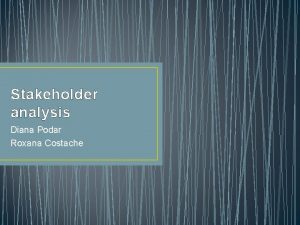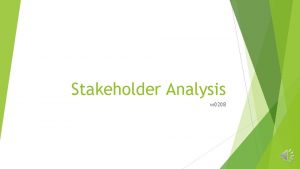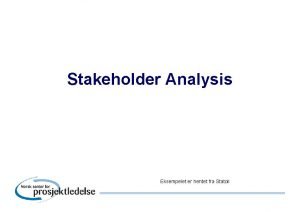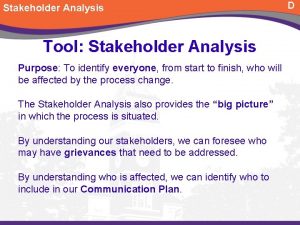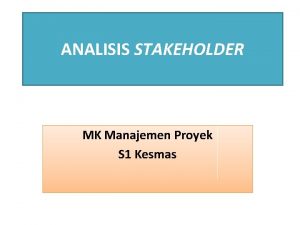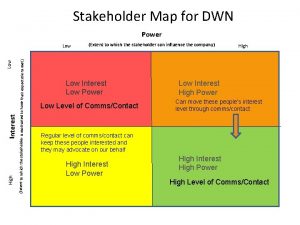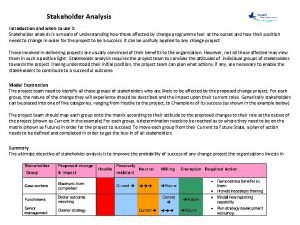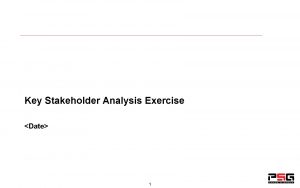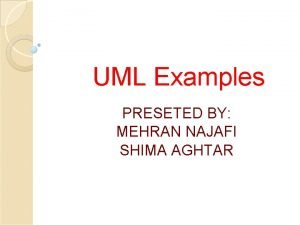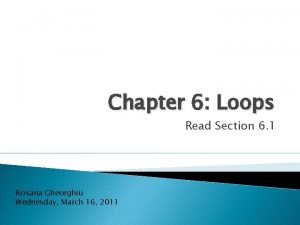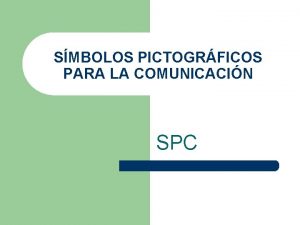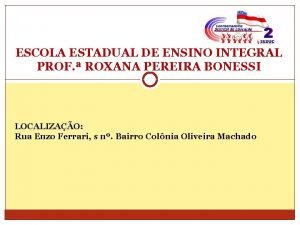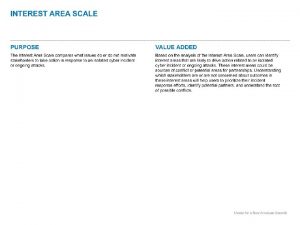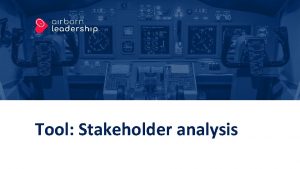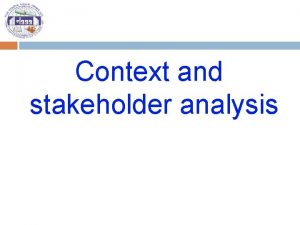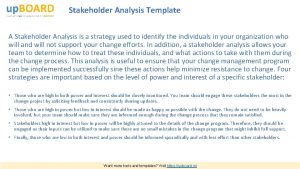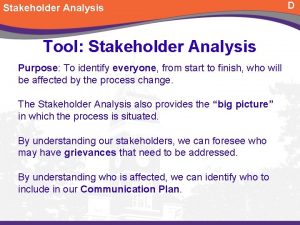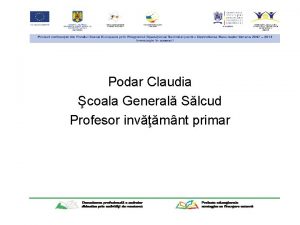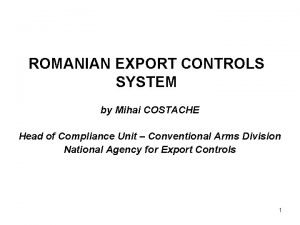Stakeholder analysis Diana Podar Roxana Costache What is































- Slides: 31

Stakeholder analysis Diana Podar Roxana Costache

What is a stakeholder? • Any individual, group, or institution who has a vested interest in the natural resources of the project area and/or who potentially will be affected by project activities and have something to gain or lose if conditions change or stay the same.

What is stakeholder analysis? • Stakeholder analysis is a process of systematically gathering and analyzing qualitative information to determine whose interests should be taken into account when developing and/or implementing a policy or program. • Stakeholder analysis identifies all primary and secondary stakeholders who have a vested interest in the issues with which the project or policy is concerned. The goal of stakeholder analysis is to develop a strategic view of the human and institutional landscape, and the relationships between the different stakeholders and the issues they care about most.

Why stakeholder analysis is important and useful? • A stakeholder analysis can help a project or programme identify: • The interests of all stakeholders who may affect or be affected by the programme/project; • Potential conflicts or risks that could jeopardise the initiative; • Opportunities and relationships that can be built on during implementation; • Groups that should be encouraged to participate in different stages of the project; • Appropriate strategies and approaches for stakeholder engagement; and • Ways to reduce negative impacts on vulnerable and disadvantaged groups.

Which characteristics are analysed? • Knowledge of the policy • Interests related to the policy • Position for or against policy • Potential alliances with other stakeholders • Ability to affect the policy process (power and/or leadership)

Steps • • 1. Planning the process 2. Selecting and defining a policy 3. Identifying key stakeholders 4. Adapting the tools 5. Collecting and recording the information 6. Filling in the stakeholder table 7. Analyzing the stakeholder table 8. Using the information

Step 1: Planning the Process • The first step in conducting a stakeholder analysis is to define the purpose of the analysis, identify the potential users of the information, and devise a plan for using the information. • Identify and train a working group - The sponsor of the activity should form a small “working group” (two to four people) whose members will be the interviewers and analysts for the stakeholder analysis. • Develop a plan and timeline - the working group should identify the specific steps to be taken in conducting the analysis (following these guidelines) and establish a timeline for the process.

Step 2: Selecting and Defining a Policy • Policy is used to refer to any national, regional, local, or institutional project, program, law, regulation, or rule. • The policy should be specific and “definable. ” • The policy should be socially and politically controversial so that it merits the investment of resources required to determine what aspects are controversial and to whom. • The policy should be key to current reform efforts and important enough to justify the resources that will be needed to implement recommended actions that emerge from the analysis.

Step 3: Identifying Key Stakeholders • Compile and review existing information. • Develop a list of all possible stakeholders. • Develop a list of priority stakeholders with input from experts.

Step 4: Adapting the Tools • The following tools can be used for gathering and analyzing this information: • • Definitions of stakeholder characteristics Stakeholder table Interview questionnaire and protocol Reference chart

Definitions of stakeholder characteristics • The working group should define the exact stakeholder information or characteristics to be considered. The following characteristics are usually included for each stakeholder: • • • I. D. number Position and organization Internal/external stakeholder Knowledge Position Interest Alliances Resources Power Leadership

Stakeholder Characteristics and Table Titles

Interview questionnaire and protocol • Once the working group has chosen and defined key stakeholder characteristics, a standard questionnaire should be developed for interviewing stakeholders. The stakeholders should not complete the questionnaire themselves, but the interviewer should use the questionnaire to guide the conversation during the interview. • Questions should be clearly stated, specific, and openended wherever possible, requiring the stakeholder to provide more than a simple “yes” or “no” answer.

Reference chart • This chart serves two purposes: • to provide a means of checking that all the stakeholder characteristics are covered in the interview questionnaire • to aid the working group in transferring the information from the questionnaire to the stakeholder table. The reference chart should be developed after the interview questionnaire and the stakeholder table because it incorporates specific interview questions and the column titles used in the stakeholder table.

Step 5: Collecting and Recording the Information • Review existing information - any written or spoken statements regarding the stakeholders’ positions on the policy, any goals or objectives of the organizations the stakeholders represent, the position of the stakeholders within their organizations, and any data on the quantity or type of resources available to the stakeholders or their organizations. • Make interview appointments - 1– 2 weeks in advance • Conduct interviews and record notes.

Step 6: Filling in the Stakeholder Table • Determine the stakeholders’ position. • The position of each stakeholder can be established by analyzing the following: • Information directly reported by the stakeholder in the interviews • Indirect information gathered through other stakeholders and secondary information (i. e. , others’perceptions) • Interest information.

Stakeholders’ position

Fill in the resources column and create a power index for each stakeholder. • 3 = the stakeholder can make decisions regarding the use of the resources in his or her organization or area • 2 = the stakeholder is one of several persons that can make decisions regarding the use of resources • 1 = the stakeholder cannot make decisions regarding the use of the resources.

Step 7 - Analysing the stakeholder table • At this point of the process we can conclude which are the most important stakeholders, what is their knowledge of the policy, their interests, their position on the policy, their view on the possible advantages and disadvantages on the policy, etc. • The "importance" of stakeholders is defined here as their ability to affect the implementation of the policy. • Since power and leadership are the characteristics that determine a stakeholder's ability to affect or block the implementation of a policy, these two characteristics are the basis for the first "importance" analysis.

Thus, yet again, three stakeholder groups will emerge: • Group 1: those who have leadership and high power (level 3) • Group 2: those who have leadership and medium power (level 2) • Group 3: those who do not have leadership but have high to medium power (level 2 or 3).

• Some of the stakeholders may not fit into any of these groups, i. e. , they may have no leadership and low power. Such stakeholders may be removed from the analysis at this point so that attention can be focused on those stakeholders within the power/leadership priority groups. • The stakeholders' level of knowledge can be presented as a general conclusion, especially if it is similar for the majority of the stakeholders, or the stakeholders can be divided by their level of knowledge (1, 2, or 3). • On the other hand, the information found in the knowledge data can be crossed with the power/leadership analysis to highlight the importance level of the stakeholders with a low knowledge level (this will result in an even smaller priority group for targeting communication strategies). • By analysing the stakeholders’ positions, the following aspects can be determined: total number of supporters, their level of importance, knowledge, advantages and disadvantages of policy implementation

Step 8 - Using the information • To which stakeholders and under what circumstances the data are presented depends on the set of objectives stated at the beginning of the analysis( e. g. to develop action plans to increase support for a reform policy, or to guide a participatory, consensus-building process, etc. ). • The presentation may include a short introduction on the stakeholder analysis, but it should focus on the results of the analysis( a concise synthesis of the most relevant information) , not on the process.

• Who is important? • One way to present the most important conclusions is to focus the presentation on the three groups that emerged from the power/leadership analysis;

Level of knowledge • As suggested in Step 7, the knowledge data can be presented in two ways: as a general conclusion, especially if the level of knowledge is similar for the majority of the stakeholders, or as a graphic representation of the three levels of knowledge (the graphic representation of the three knowledge groups is particularly useful in cross-referencing the power/leadership information with the use of colored boxes).

• The level of interest may be represented as a list of advantages and disadvantages of the program’s implementation or can be crossreferenced with the other levels of analysis, in order to obtain a more comprehensive image. • presentation of key alliances may help identify those stakeholder clusters which may support or oppose the policy

• additional results- in addition to the information listed on the stakeholder table, other information gained from the interviews can be used to develop key results and conclusions ; • For example: • stakeholders who were not included in the priority list but were mentioned often by those interviewed; • suggestions for the implementation of the policy; • any expectations that the majority of the stakeholders have in relation to the policy;

Presenting the results

Presentation of recommended strategies • Finally, the working group presenters should always place the results within the context of recommended actions and next steps so that the sponsor and other policymakers or managers know how to use the results. • To guide these follow-up actions, the working group should develop strategies to achieve the following five basic goals: 1. Maintain the support of those stakeholders who are currently supporters 2. Increase power and leadership of the supporters 3. Convert the opponents to supporters 4. Weaken the power and leadership of the opponents 5. Convert the neutral stakeholders into active supporters (i. e. , convince them to support the policy and increase their power and leadership where necessary).

• The group can recommend that the following stakeholders be targeted for the first stage of strategy implementation: • Supporters with little power and leadership: focus on ways of increasing the power and leadership of these stakeholders. • Neutral stakeholders with medium to high power and leadership: focus on convincing the takeholders to support the policy and increasing their power and leadership where necessary. • Opponents with high power and leadership: focus on negotiating for the opponents' support and decreasing their power and leadership if they remain opposed.

Limits • First of all, stakeholder analysis may be over-used, therefore, it must be mentioned that this method is not a purpose in itself and a representation of reality, not reality itself (Crosby, 1991; Hyder et al, 2010); • Second of all, due to a dynamic environment and its cross-sectional character, it may become irrelevant and obsolete on the long-term (Varvasovszky & Brugha, 2000); • Finally, some biases in conducting and interpreting the analysis may occur, like the Hawthorne effect, implication bias( some stakeholders may be more willing to participate than others), conflicts between the stakeholders’ attitudes and principles and those of the company they belong, real disclosure level, etc.

References • Hyder, A. , Syed S. , Puvanachandra P. , Bloom, G. , (2010). Stakeholder analysis for health research: Case studies from low- and middle-income countries, Public Health, pp. 159– 166. Retrieved from http: //www. publichealthjrnl. com/article/S 0033 -3506%2810%2900003 -X/pdf; • Schmeer, K. , (1999). “Stakeholder Analysis Guidelines” , in Policy Toolkit for Strengthening Health Sector Reform, Abt Associates, Inc. , Bethesda, MD. Retrieved from http: //www. who. int/entity/management/partnerships/overall/Guidelines. Condu cting. Stakeholder. Analysis. pdf. ; • Varvasovszky, Z. , Brugha, R. (2000). Stakeholder analysis: a review, Health Policy and Planning, Vol. 15, pp. 239– 246. Retrieved from http: //heapol. oxfordjournals. org/content/15/3/239. short; • Varvasovszky, Z. , Brugha, R. (2000). How to do( or not to do) A stakeholder analysis, Health Policy and Planning, Vol. 15, pp. 338 -45. Retrieved from http: //heapol. oxfordjournals. org/content/15/3/338. short;
 Roxana costache
Roxana costache Podar school books
Podar school books Edad de diana alvarez del diario de diana
Edad de diana alvarez del diario de diana Carmen tocala
Carmen tocala Costache giurgiuveanu
Costache giurgiuveanu Enigma otiliei personaje caracterizare
Enigma otiliei personaje caracterizare Baraba costache ioanid
Baraba costache ioanid Scena logodnei din maitreyi
Scena logodnei din maitreyi Stakeholder analysis fashion industry
Stakeholder analysis fashion industry Onion model stakeholder analysis
Onion model stakeholder analysis Eksempelet
Eksempelet Stakeholder analysis template
Stakeholder analysis template Stakeholder perusahaan
Stakeholder perusahaan Stakeholder analysis
Stakeholder analysis Stakeholder analysis exercise
Stakeholder analysis exercise Stakeholder analysis exercise
Stakeholder analysis exercise Roxana bravo
Roxana bravo Dr. roxana viera
Dr. roxana viera Preseted
Preseted Roxana del aguila dermatologa
Roxana del aguila dermatologa Roxana knobel
Roxana knobel Dr roxana darabont
Dr roxana darabont Profesora roxana
Profesora roxana Samanta computer
Samanta computer Roxana sfetea
Roxana sfetea Roxana chapter 4
Roxana chapter 4 Shawshank redemption motifs
Shawshank redemption motifs Roxana mayer johnson
Roxana mayer johnson Roxana gavriloaia
Roxana gavriloaia Dr roxana viera
Dr roxana viera Escola roxana pereira bonessi
Escola roxana pereira bonessi Whats a stake holder
Whats a stake holder
